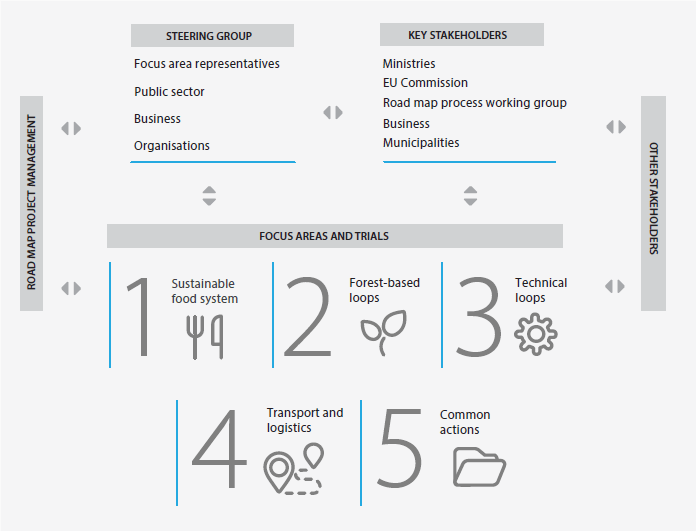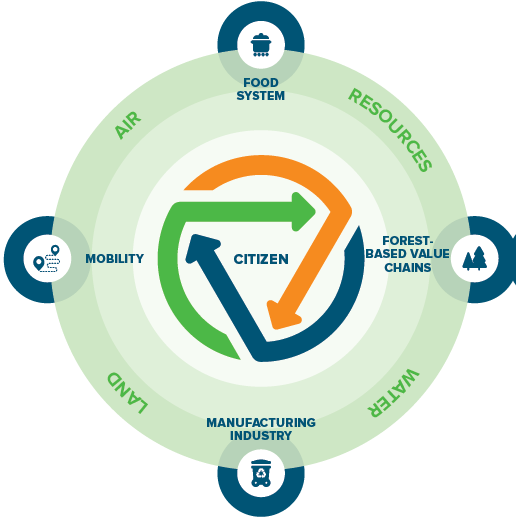Finland
The circular economy strategy in Finland aims to achieve the status of a world leader in the circular economy by 2025. For this purpose:
- Comprehensive circular solutions targeted at the development of entrepreneurship and exports will be implemented: Finnish organizations operating in various sectors will be involved in the implementation of the circular model at the global level.
- Functionality of the domestic market will be ensured: the state will play a key role co-creating the socio-economic environment and determining the direction of thinking, but the choice of methods will remain a matter of other entities.
- Fast and concrete actions based on pilot actions will be implemented: at the same time, the implementation of extensive, long-term regulations promoting the transition to the circular model will be supported.
By 2025, Finland wants to strengthen the competitiveness of the economy, create new jobs and ensure sustainable growth. Detailed goals are:
- A circular economy will improve the competitiveness of Finland and Finnish organizations, increasing their perception as innovative and resulting in turnover growth and new technologies development.
- Circular economy solutions will become export goods, bringing benefits to Finland and increasing the willingness to internationalize enterprises.
- The reformed financing models will support the circularity of the economy: public procurement, new models of cooperation between the private and public sectors and cooperative activities will be used to a greater extent.
- Ecological benefits and better environmental conditions will create new opportunities for economic growth and entrepreneurship.
- Improving resource efficiency.
- The material circulation cycle will become more efficient, non-renewable natural resources will be replaced by renewable ones, waste-free environment, neutral in terms of greenhouse gas production will be supported.
- A circular economy will improve the robustness of the environment.
- Environmental impact control will improve.
- Concepts related to the circular economy will be taken into account in the development of social strategies.
- A circular economy will ensure the well-being of society by promoting the transition to a service-based sharing economy.
- Public awareness of the circular economy will increase, raising demand on the domestic market and focusing on circular products and services.
- Consumers will adopt new consumption patterns, e.g. increase in shared services and recycling.
Entities responsible for the implementation of circular economy in Finland and their relations

The main activities described in the Finnish strategy are classified in the following areas:
Sustainable food system
Consumers choose food that has been produced through smarter use of raw materials, starting from basic agricultural production. Emissions and consumption of resources will be significantly lower.
Forest based loops
Finland is the leader of the circular bioeconomy. By implementing the strategy, the global competitiveness of this industry will be additionally increased due to the emergence of new products, services, cooperation models and technologies.
Technological loops
Minimizing the use of primary raw materials creates a competitive advantage. At the same time, the life cycle of materials and products as well as opportunities for reuse will be maximized.
Transport and logistics
Transport will transform into an efficient, intelligent system that will not use fossil fuels. The concepts of mobility as a service (MaaS) and sharing economy will be supported.
Slovenia
The first Slovenian action plan on the circular economy aims to pave the way for the transition from a linear economy to a circular economy through the involvement of all stakeholders.
The circular economy action plan in Slovenia introduces four priority areas of action assessed as those with the potential to increase the productivity of material and raw materials, maximize the value of materials, products or services, develop circular business models, strengthen energy efficiency, close material flows , prevent waste generation, integrate green public sector activities, strengthen new consumption patterns and support circular society.
Priority areas for the implementation of circular economy in Slovenia

Selected priority areas are:
The high potential of activities in this area is related to self-sufficiency and the possibilities of local food production. There is a need for better integration of food producers and improvement of their links with the catering and tourism industry. It is necessary to increase public knowledge in the field of food production and preparation, as well as regarding guidelines for the reduction of food waste and biomass management.
A strategic partnership in research and innovation is needed resulting in the possibility of expanding knowledge and developing new projects. The accent in this case is put on small and medium enterprises. These entities need the most help and incentives to develop innovative projects and to take advantage of the opportunities to participate in tenders throughout Europe. Current communication and promotional activities are not effective enough.
Dissemination of good practices is of great importance for the promotion of circular economy and education of entities that have already entered the path of transformation towards a circular model. This applies in particular to promoting products as services, moving away from ownership to joint ownership and replacing consumers with users.
Due to its geographical location, Slovenia can become a green mobility laboratory and take a leading role as a country demonstrating new solutions in this field and exporting green mobility technology to international markets.
In order to better understand the complex, comprehensive and, above all, long-term process of transition to the closed-loop model, the Slovenian strategy uses the concept based on three basic aspects enabling the implementation of circular economy.
These aspects are:
- "Circular economy" - an emphasis on transformations towards circular business models
- "Circular Change" - a comprehensive policy supporting the transformation of the public sector so that it creates an environment that is friendly to the circular economy
- "Circular Culture" - reflection on the values of society and citizens and an attempt to shape them in the direction corresponding to the assumptions of the circular economy concept
France
The strategy for closed circulation in France assumes the following objectives:
- Reduction in the use of natural resources in relation to GDP by 30% in 2010-2030. Reduction of landfill for non-hazardous waste by 50% by 2025 compared to 2010.Plastic recycling at 100%.Reduction of greenhouse gas emissions (by 8 million tons of CO2 per year as a result of plastic recycling).Creation of 300,000 new jobs, also in new branches
This strategy assumes separate road maps for the identified priority areas.
It assumes support for modernizing and differentiating products based on better raw material productivity, limiting the use of non-renewable resources, decreasing the use of recyclates, creating new workplaces, meeting the requirements for new skills needed for functioning in the circular economy.
Assumes consumer support in more sustainable consumption, extending shelf life of products, creating jobs in the sector related to the repair of products, reducing food waste.
Assumes a 100% collection of waste that can be recycled, simplified waste sorting process, ceasing to dispose biomass to basic garbage containers
It assumes information, education and training of all stakeholders in terms of the concepts and principles of circular economy, the role of public procurement, the mobilization of local authorities and enterprises in individual regions, support for the transition to a circular model through appropriate financing.
In total, all road maps mentioned consist of fifty individual actions of public authorities, society and enterprises.